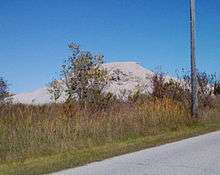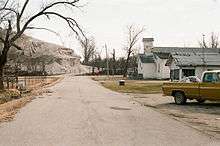Tar Creek Superfund site
| Tar Creek | |
|---|---|
| Superfund site | |
 | |
| Geography | |
| City | Picher |
| County | Ottawa County |
| State | Oklahoma |
| List of Superfund sites | |
Tar Creek Superfund site is a United States Superfund site located in the cities of Picher and Cardin, Oklahoma. Chat piles left behind by the mining companies contain lead dust that has blown around the city. Elevated lead levels in Picher children have led to learning disabilities and other problems. The lead and zinc have also seeped into groundwater, ponds, and lakes, many of which still are used by children for swimming. Since the children of Picher have been found to have elevated levels of lead in their bodies, the EPA has since declared Picher to be one of the most toxic areas in the United States.[1][2]
This area was originally owned by the Quapaw Nation of Oklahoma, who leased property to mining companies. Government rules restricted many Quapaw landowners from realizing money from royalties that companies paid on these leases. The people have suffered adverse health effects, including high rates of miscarriage and neurological damage to children, as a result of the unregulated mining activities. The Tar Creek Superfund site is the Oklahoma section of three sites that together encompass the Tri-State district. This is an old lead and zinc mining district that included parts of southwest Missouri, southeast Kansas, and northeast Oklahoma.
Origins of the Tar Creek Superfund Site

The area now known as Tar Creek is part of the Tri-State mining district, an area of 1,188 square miles located in Ottawa County, Oklahoma; Southwestern Missouri, and Southeastern Kansas. The first mining activities took place in Missouri around 1850. By 1908, sites had been started in Miami, Picher, and Commerce. The construction of railroads in the area stimulated production, increasing access to markets. Mining quickly had a high economic impact, and by 1924 most of the young, American-born whites in the district were employed by the mining industry.[3] The Quapaw tended to be excluded by discrimination in the industry.
When mining began in the area, most of the land was owned by the federally recognized Quapaw tribe. An 1897 court ruling and subsequent lawsuits determined mining companies could exploit resources on leased Quapaw lands, but only about one sixth of Quapaw landowners were allowed to collect royalties. Between 1915 and 1930, decreasing demand and production caused companies to buy the land rather than lease it, which encouraged high consolidation of mining companies.[3]
During World War I, the region supplied 45 percent of the lead and 50 percent of the zinc used by the U.S. Advances in technology resulted in increases in production. 1926 was the highest year of production in the area, and Ottawa County became the world's largest source of lead and zinc. Between 1908 and 1950, the entire Tri-State Mining Region generated over an estimated 1 billion U.S. dollars. After 1950, many of the mines were shut down, largely due to findings about their adverse environmental impacts on soil, groundwater and air.[3]
National and state intervention

In the 1960s and 1970s, health and environmental hazards were found at mining and industrial sites across America, such as Times Beach and Love Canal. Congress passed on December 11, 1980, the Comprehensive Environmental Response, Compensation, and Liability Act (CERCLA).[4] The environmental programs and initiatives established by CERCLA are referred to as the Superfund: hazardous sites were identified and financing was allocated to remediate them. The EPA established a Hazard Ranking system and a National Priorities List in 1981 and 1982, respectively. The Tar Creek site was designated a Superfund site in 1983, and work on the first Operable Unit (OU) occurred in 1984.[5]
In 2004, the state of Oklahoma enacted the Oklahoma Plan For Tar Creek. However, in 2006, most of this money was reallocated to a relocation program, due to the immediate health hazards to those residents still living in the area.[5]
Health and environmental hazards in the Tar Creek Region
"Dry" and "wet" methods were used by mining companies to extract pure lead from ore. Dry methods produced chat piles, and wet methods required tailing ponds to process ore into a usable product (see Chat (mining) and Tailings). The Oklahoma Plan for Tar Creek claimed around 75 million tons of chat piles exist, while the exact amount of tailings is unknown.[5] Chat piles are large mounds of mining waste. It was not uncommon for children in the area to play around the chat piles, such as riding bikes up and down the large piles or swimming in waters contaminated by their dust or groundwater effects. Some of the piles were used for school students for track practice.[1][6]
Lead poisoning is especially hazardous to children under six years of age.[5] High levels of lead at this age can produce impaired neurological development that results in lifelong problems. A 1996 study showed 43% of children ages 1–5 had blood lead concentrations above the threshold considered dangerous by Federal standards (more recent reports show this number to be lower[7]). Another indication of hazard is that the miscarriage rate for women in the area is 24%, compared to the national average of 10%.[6] Empty mines also present an immediate danger due to mine collapses. One collapse in 1967 took nine homes.[1]
Lead can have marked adverse environmental impacts, especially in aquatic systems. Water from the region eventually drains into the Grand Lake o' the Cherokees. This has led to raised levels of lead in the lake. There is a health advisory for people to limit the number of fish from this area that they consume.[7]
Damage to water resources and aquatic life
Often, waste materials from mining were dumped into exploration holes dug to map out mining areas. After mining ceased in the 1960s, the mines flooded and these waste materials began to mix in with the rest of the water that filled the mines. Eventually, this water reached the surface, forming "springs" of contaminated water at the site of the exploratory drilling holes.
To keep groundwater from saturating the mines while they were active, water was pumped out of mines. This created a large depression where mining activities occurred. Mined-out portions were used to store waste materials and poor quality ore instead of removing them from the mines. These waste materials reacted with moist air and oxidized. When mining ceased, so did the active pumping of water out of the mines. Thus, water flowed back into the depressions left by mines, and reacted with the oxidized and now more reactive heavy metals left over. Eventually, enough water filled the mines that they exceeded the elevation of the area, thus allowing water to travel to the surface. The first contaminated springs of water were documented in 1979, and in 1980 Picher first recorded contaminated water drawn from the town's aquifer.[8]
Estimates in 1982 showed lead and cadmium levels in the underground aquifer of Picher were five times the national standards for drinking water.[8] Mine water has to be treated to prevent its contaminating other clean water sources, such as nearby Grand Lake, which already has elevated levels of lead due to mining activities (see above). Photosynthetic organisms in the water have no means to dispose of heavy metals they absorb and accumulate these. Any animal or fish that feeds on this primary producer accumulates the higher concentrations of these contaminants, as the primary producer has a higher concentration of heavy metals relative to the water. Secondary and tertiary consumers accumulate even higher concentrations of such metals (for more information on this process, see biomagnification). Since humans consume fish rather than phytoplankton, they are considered a secondary consumer, and are at high risk of lead poisoning from fish taken from contaminated lakes.
Remediation efforts
Since the passage of CERCLA, numerous remediation efforts have been conducted in the area. The Oklahoma Plan for Tar Creek has listed four main objectives in the process: improving surface water quality, reducing exposure to lead dust, attenuating mine hazards, and land reclamation.[5]
To improve water quality, the University of Oklahoma has implemented a 1.2 million dollar passive water treatment system. This system uses gravity and renewable energy to flow water through a filtration system, composed of aerobic and anaerobic bacteria treatments, and periodic oxidation of treated waters. This project has greatly reduced the presence of dangerous heavy metals in treated waters.[5][7]
To reduce the exposure to lead dust, the Oklahoma plan for Tar Creek proposes to pave over chat roads and otherwise encapsulate chat to avoid airborne lead dust. The plan is designed to determine the maximum amount of chat that can be mixed with asphalt while minimizing the risk of exposure. A chat and asphalt mixture may also be used to fill mines, which will reduce the threat of mine hazards--namely, the collapse of mines and/or the exposure to lead due to open or collapsed mines.[5][7]
Finally, the plan calls for the restoration of the land damaged by mining activities. After the direct threat of lead in chat piles is addressed, land will be revegetated or removed and replaced by new soil. One 2011 estimate claims an additional 3.2 million dollars will be sufficient to remediate the more than 400 mining sites remaining in the area.[5][7]
Representation in other media
The Tar Creek Superfund site was the subject of a documentary film, Tar Creek (2009). Written, directed, and narrated by Matt Myers, the film covers the gamut of the issues related to the Tar Creek Superfund site, including lead poisoning, mine waste, acid mine water, sinkholes, governmental practices showing racism against the Quapaw Tribe, downstream expansion of the superfund site, and the eventual federal buyout of the residents of the area.
During the Fall of 2010, Tar Creek toured to many of the nation's existing Superfund sites as part of the Superfund Screening Tour. Universities, organizations, churches, and schools used the story of Tar Creek to have a discussion about what could happen in their communities.
See also
References
- 1 2 3 "Pollution busts Okla. mining town" - Associated Press - (c/o MSNBC) - May 10, 2008
- ↑ Juozapavicius, Justin. - "Oklahoma Town Is Toxic Waste Site" - Associated Press - (c/o San Francisco Chronicle-SFGate.com) - February 27, 2007
- 1 2 3
- ↑
- 1 2 3 4 5 6 7 8
- 1 2
- 1 2 3 4 5 http://www.tulsaworld.com/site/printerfriendlystory.aspx?articleid=20110927_11_A1_CUTLIN900375
- 1 2
Specific pages used in the Oklahoma Department of Environmental Quality page (Reference #5) included in the external links section
External links
- Tar Creek Site, EPA, numerous documents, links, photos
- Tar Creek, documentary
- Senate Bill 1463 Oklahoma bill to relocate families in Tar Creek area
- Oklahoma Plan for Tar Creek
- Fish Consumption Guide for Tar Creek and Grand Lake
- Ottawa County Map, OKDOT
Coordinates: 36°58′32″N 94°50′17″W / 36.97556°N 94.83806°W